Trompe l'oeil Tricks:
Borges' Baroque Illusionism
Lois Parkinson Zamora
University of Houston
Artistic devices of spatial illusion were developed in Europe during the seventeenth-century—the century of the style we now refer to as Baroque—in response to cultural anxieties occasioned by revolutionary scientific discoveries, revolutionary religious upheaval, also by the new taste for virtuosic visual display. The authority of perception was being undermined, and Baroque artists responded accordingly—and often fantastically—with structures intended to deceive the eye—the literal meaning, of course, of trompe l'oeil. Trompe l'oeil paintings were known long before the Baroque period, and long after, for that matter—René Magritte is our greatest twentieth-century practitioner and, indeed, an artist to whom Jorge Luis Borges has occasionally been compared.
René Magritte, "The Human Condition"
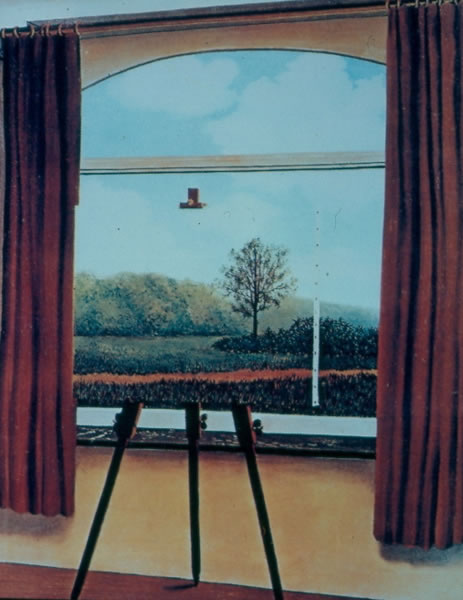
Magritte, "The Human Condition"
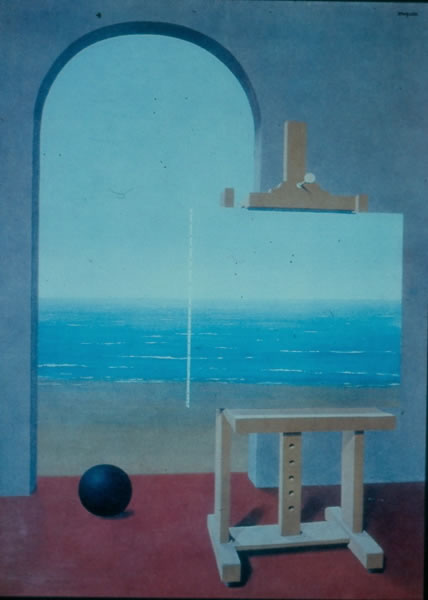
Magritte, "Key of the Fields"
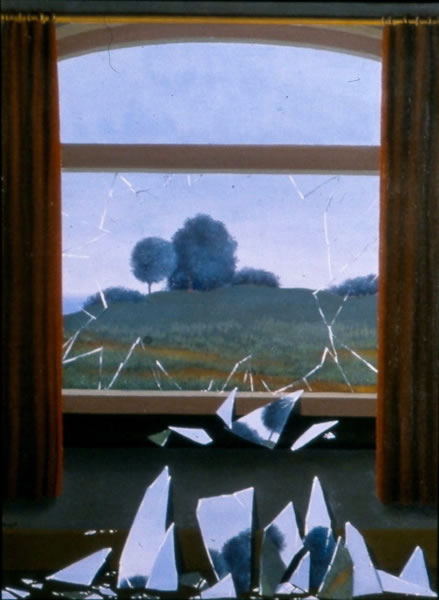
But my interest here is not in Magritte, but in the self-reflexive devices and perspectival manipulations that are easily recognizable as Baroque.
Andrea Pozzo, "Allegory of the Missionary Work of the Jesuit Order" (1691-94), Church of San Ignacio, Rome,
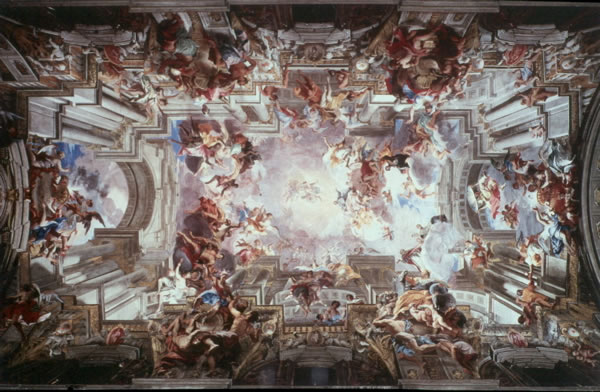
Examples come in all sizes, shapes and media, but in every instance, whether monumental frescoed ceilings—here, Andrea Pozzo's ceiling in the Church of San Ignacio in Rome—or more modest still lifes or domestic scenes such as Raphalle Peale's nineteenth-century, tongue-in-cheek parody of a Baroque theme, entitled "Venus Rising from the Sea—A Deception (After the Bath).
Peale, "Venus Rising from the Sea—A Deception (After the Bath)"
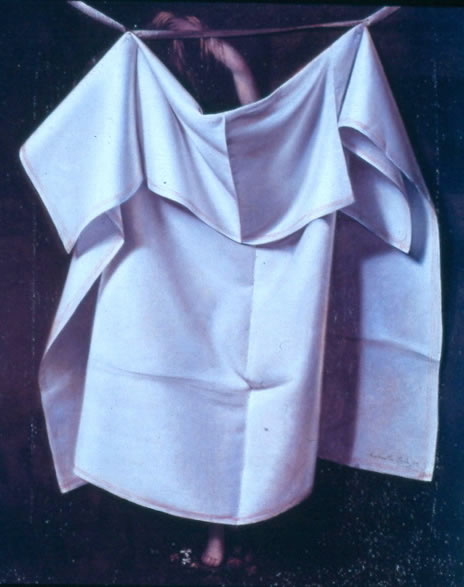
Trompe l'oeil images share an affective intention of double wonderment: first, to make their viewers wonder "Is this real? and What is real?" and, second, to make us wonder (in the sense of "marvel") at the artist's virtuosity in provoking such questions in the first place. Whereas Renaissance naturalism strove to represent the real by offering viewers the proverbial "transparent window" through which to observe scenes and personages, Baroque illusionism subverts this kind of realistic representation by calling attention to its own artifice, to its own perspectival manipulations, and thus to the problematic nature of referentiality as such. Another example of Baroque trompe l'oeil on a grand scale:
Baciccio, "Glory to the Name of Jesus," Church of Gesù, Rome
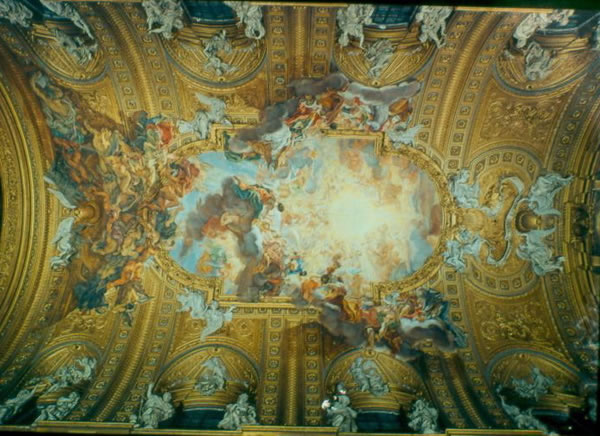
In short, Baroque trompe l'oeil painters challenge the conventions of Renaissance, fixed-point perspective—what is referred to as Albertian perspective, after Leone Battista Alberti, the early Renaissance architect and Humanist who codified these conventions. (It is, of course, the "transparent window" of Albertian realism that René Magritte is parodying in his repeated tromope l'oeil windows that we have just seen.) Trompe l'oeil deploys the same conventions of Albertian perspective but to their extreme, manipulating them self-consciously in order to distort or undermine their own mimetic claims. Central to all trompe l'oeil images, then, is this debate of art with itself—this spectacle of realism engaged in an assault on its own realistic claims. I will propose that Jorge Luis Borges uses trompe l'oeil devices to similar effect. In his fiction, as in trompe l'oeil paintings, realistic referentiality is deployed and then disrupted; mimetic devices are engaged in their own undoing.
But first, a few more visual examples. I have said that Baroque tromple l'oeil comes in all shapes and sizes. Consider the architectural illusionism so favored by Baroque artists. This seventeenth-century nave ceiling fresco by Baciccio in the Gesù Church in Rome creates the illusion of infinite extension by belying the real bounds of its actual physical space. It is, instead, an illusory space that aspires to contain the universe and to be co-extensive, furthermore, with the divine. The vanishing point has been removed, as it were, and space is projected—presumably infinitely—behind the picture plane of architectural surface, angels, and other realistically portrayed foreground elements.
Baldassare Peruzzi, "Sala delle Prospettive," fresco, c. 1515, Villa Farnesina, Rome
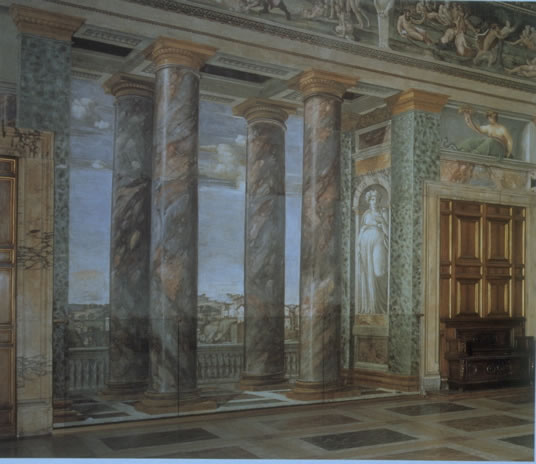
Architectural illusionism was known in antiquity and revived in the early fourteenth century, notably by Giotto, but the great vogue begins in the sixteenth century in Italy, and continues in the seventeenth throughout Europe, when interior walls and ceilings of secular buildings were also frescoed with grand vistas of exterior spaces. This is a flat wall in the Villa Farnesina in Rome—are those real doors and benchs? We wonder. And another example in the Pitti Palace in Florence:
Angelo Michele Colonna and Agostino Mitelli, detail from "The Triumph of Alexander the Great," 1638, Palazzo Pitti, Florence
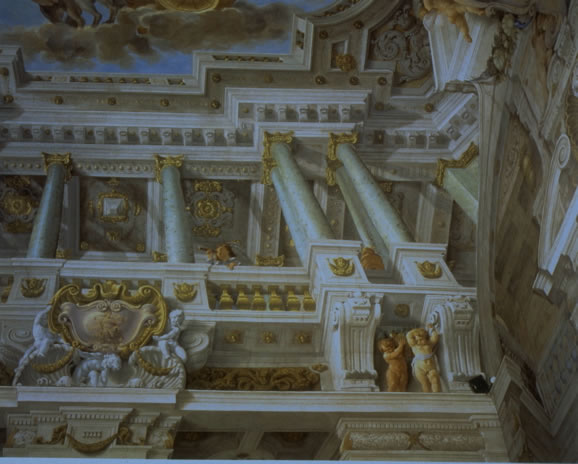
The combination of hyperbolic space and minute attention to pictorial detail again predicts the work of Jorge Luis Borges, for he, too, strives to create the illusion of infinite extension amidst richness of material detail in such stories as "The Aleph," "The Library of Babel," and "Tlön, Uqbar, Orbis Tertius." His texts, like these painted surfaces, explore not so much what is real and what is not, but rather the multiple (and often deceptive) orders of the real. The aim of this kind of trompe l'oeil, whether textual or visual, is, then, not merely to undermine realistic representation but also to amplify the viewer's or reader's experience of the real by pointing to realms that are impossible to represent realistically.
Consider, for example, the Baroque "perspective construction" in Borges' story "The Library of Babel," with its minute description of the vast geometry of the Library, its mathematically measured distances and identical corridors, staircases and towers, each with its exactly numbered shelves, books, pages, lines and letters—even as we are also told that the Library is infinite, immeasurable, unknowable. Here Borges dispenses with the Albertian frame that fixes the distance between viewer and represented space, and instead projects the illusion of infinite space behind the "picture plane" of his realistic description. His narrator describes infinite spatial extension at the same time that he also pays assiduous attention to material detail, not failing to notice "two very small closets": "In the first, one may sleep standing up; in the other, satisfy one's fecal necessities." (51) Later, he again juxtaposes the "inexhaustible stairways for the traveler and latrines for the seated librarian." (52) This hilarious negotiation between infinite space and the functional constraints of real human bodies allows Borges to parody both the mimetic assiduousness and the metaphysical aspirations that underpin Baroque architectural illusionism, while at the same time adopting the paradox upon which their effect depends: the disjunction between the limited space of artistic representation and human selves on the one hand, and the disembodied illusion of infinite extension on the other.
Baroque perspectival manipulations, though, are not necessarily vast in intention.
Franciscus Gijsbrechts, "Glass Cupboard door", 1679, Flemish
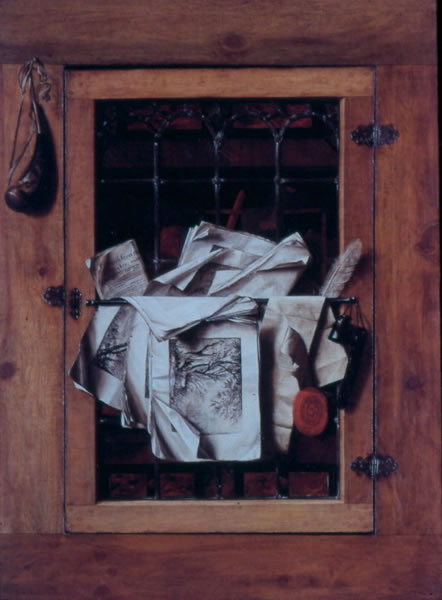
Cupboards, cabinets and niches filled with a welter of things became staples of Baroque trompe l'oeil painting precisely because they, too, allow the artist to manipulate (and disrupt) Albertian perspective. Here, in a painting entitled "Glass Cupboard Door" by the Flemish painter Franciscus Gijsbrechts, the Albertian vanishing point is truncated by the flat surface of the cupboard door and the back of the cupboard seen partially through the glass—a painted plane that appears to coincide with the surface of the canvas itself. Unlike the architectural illusionism that we have just seen, which projects the illusion of infinite space behind the picture plane, here the illusion consists in projecting space in front of the picture plane. The challenge to the painter's skill at mimetic deception is to subvert the picture plane by making something as flat as paper.
Detail, Gijsbrechts
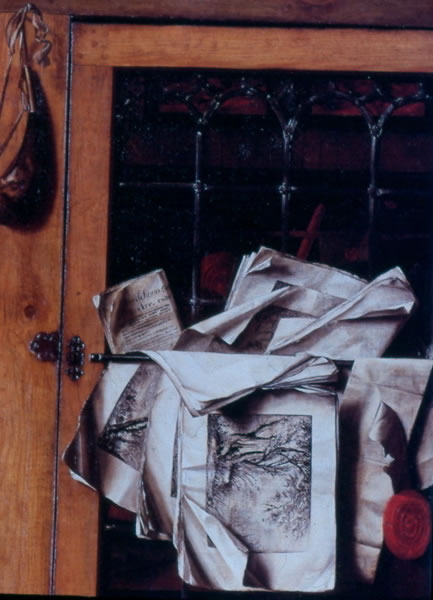
appear to protrude into the viewer's space. As we see, the folds and creases in the paper present ample opportunity for perspectival play.
Juan Sánchez Cotán, "Quince, Cabbage, Melon and Cucumber" (Spain 1602)
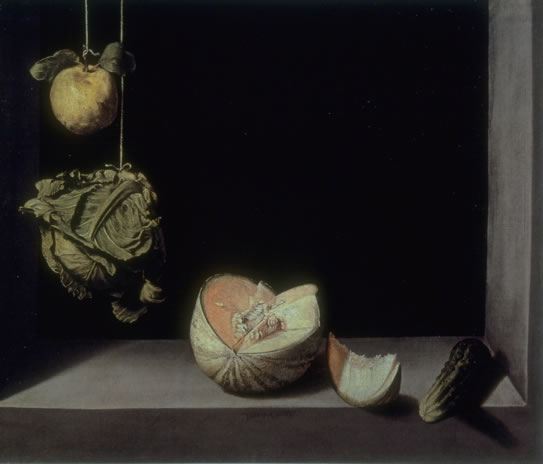
Similarly in this still life by Juan Sánchez Cotán, entitled "Quince, Cabbage, Melon and Cucumber," the picture plane is defined by the wall that frames the recessed larder, but a slice of melon and the end of a cucumber rupture the picture plane, appearing to protrude into the viewer's space. Again, the separation between pictorial space and the viewer's space—the separation pon which Western realism depends—is undone. Sánchez Cotán's vegetables and fruit are not painted images at all, but objects in the viewer's world.
I want to pursue a set of trompe l'oeil devices that "rupture the picture plane" of realistic representation in similar ways. If Sánchez Cotán's painted objects protrude into the viewer's world in order to disclaim their status as painted objects, the devices I want to show you now do something like the opposite.
Jacobus Biltius, "A Trompe l'Oeil," Dutch, 1678

These objects also pretend to occupy the viewer's space, but they do so but calling attention to the painting as painting, as a two-dimensional artifact, as unreal. They are pictorial details—here, the nail and the insects—that are supposedly on the surface of the painting, and thus outside of the represented scene and in the real space of the viewer. Such "outside" details became conventional in Baroque trompe l'oeil painting: a nail that apparently affixes painted objects to a wall, as above; a small piece of paper, apparently pasted onto the surface of the canvas—
E. Hiernault, "Still Life of the Back of a Painting with a Hebrew Bookplate," 1766
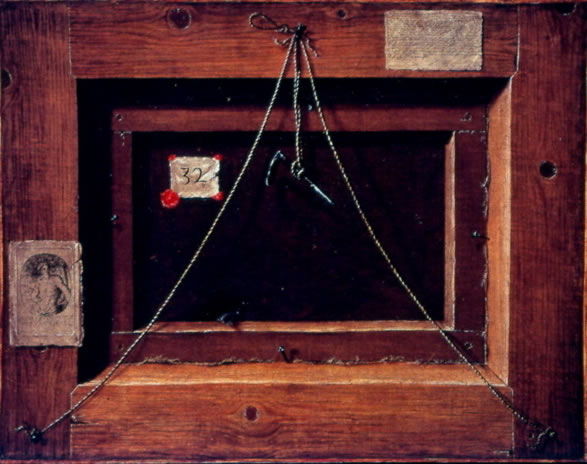
or in this case, on the back of the painting. In fact, the backs of paintings were not-infrequent subjects of Baroque trompe l'oeil painting, because they too undermine the Albertian fiction of painting-as-transparent-window by depicting the painting-as-object—an object, here, equally fictional because equally painted, but one that impels the viewer to the double wonderment of which I have spoken: is the object is real? Is it the real back of a real painting, or a painted back of an non-existent painting? And we wonder, too, at the artist's ability to make us wonder.
Another conventional trompe l'oeil intrusion is the fly, which sits on the surface of the painting and—again—blurs the boundaries between real and represented, because the fly pretends to occupy the space of the viewer rather than the space of the painting.
Studio of Carlo Crivelli, "Saint Catherine of Alexandria," Venetian
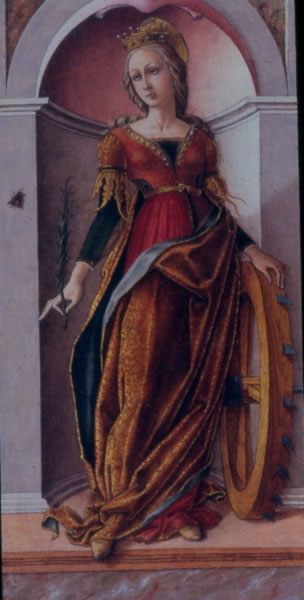
Sebastiano del Piombo, "Cardinal Bandinellos Sauli and Three Companions," c. 1516
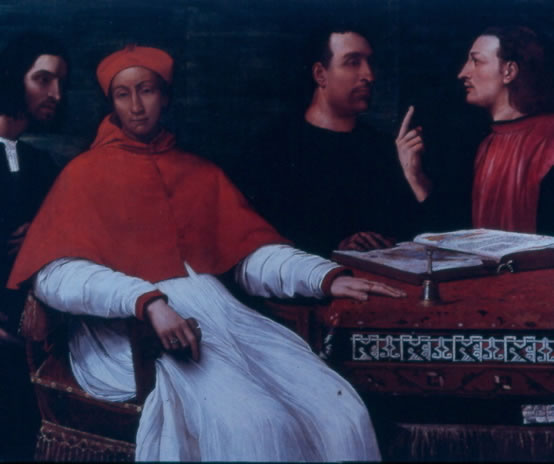
Curtains are used to similar effect:
Gerrit Dou, "Painter with Pipe and Book," Dutch, c. 1645
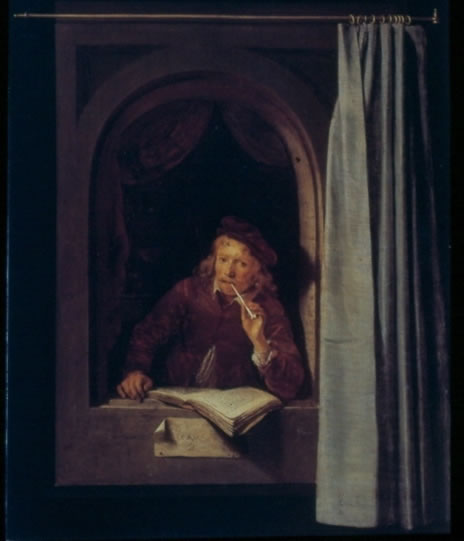
Gerard Houckgeest, "The Interior of Saint Gertrude in Bergen op Zoom," c. 1655
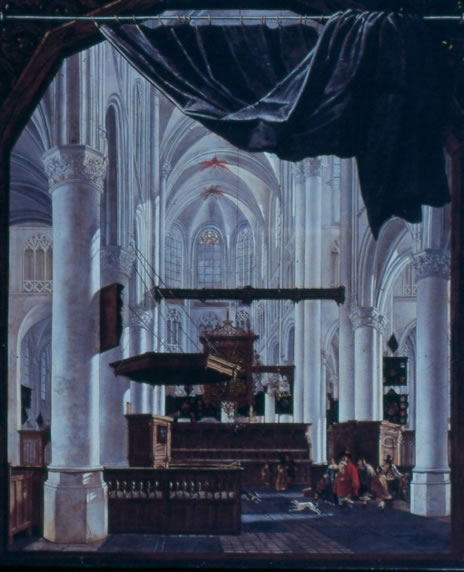
—to suggest that the painted scene is fictional, but that the curtain, which may be drawn across the painting to protect it from overexposure, is "real" because it exists in the space of the viewer. These "intrusions"—or alternative layers of represented "reality"—fly, nail, curtain—usurp the mimetic claims of the painting by themselves claiming to be real.
In like fashion, Jorge Luis Borges blurs the boundaries of represented "realities" in his postscript to "Tlön, Uqbar, Orbis Tertius," when two objects from the "ideal" world of Tlön intrude into the "real" world of the narrator. These objects, a compass and heavy metal cone, are described in his postscript as "...intrusions from this fantastic world into the world of reality." The compass and metal cone are like the flies, the nails, the curtains and cucumbers in the trompe l'oeil paintings we have just seen; they penetrate the normally sealed "picture plane" of narrative realism, confusing the "inside" and "outside" of the realistic frame, causing multiple and contradictory orders of reality to intermingle in ways ordinarily forbidden by the conventional of narrative realism.
Similarly in "The Library of Babel," Borges multiplies narrative levels with his footnotes. If, as we have said, the illusory infinity of Borges' Library of Babel, like Baroque architectural illusionism, is projected behind the picture plane of mimetic description, the footnotes to his story—small print, specific, matter of fact—are projected in front of the narrative frame into the finite, "real" space of the reader—again, like the flies in trompe l'oeil paintings. Furthermore, one of the footnotes is labeled "editor's note," adding yet another perspective to the text—yet another fly, as it were—on the realistic surface of the story.
In all of our examples, visual and textual, we encounter this essential irony: the more successful the trompe l'oeil artist is at hiding himself—at pretending that his work is not fictional but real—the more his artistry calls itself to our attention, and the more we are compelled to admire his dexterity as an artist. In this respect, the illusionist bears an uncanny resemblance to the forger, or to God, whose divine miracles are, indeed, often presented in Baroque paintings as trompe l'oeil moments in otherwise realistic contexts.
José Juárez, "San Alejo," 17th century Mexican
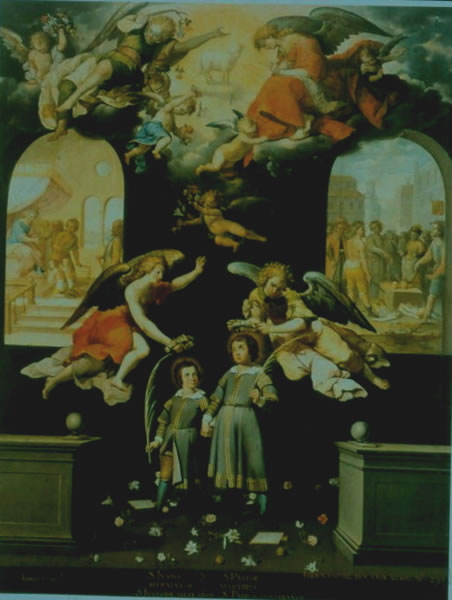
Carlos Clemente López, "San Juan Nepomuceno," 18th century Mexican
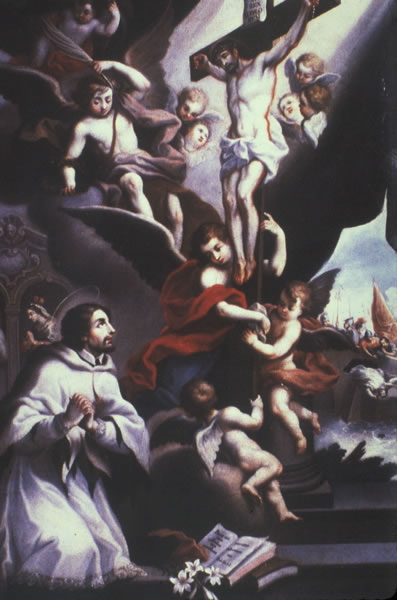
Saints' lives, and particularly martyred saints' lives, are often depicted as realistic narratives interrupted by miraculous glimpses of infinity—a structure of co-existing realities that Borges brilliantly ironizes in his story "The Secret Miracle."
Recall that Borges' character in "The Secret Miracle" stands before a firing squad in Nazi Germany but is granted a year's reprieve to finish his life's work. At the end of the story, we learn that this reprieve is an illusion, that the year (fully experienced and realistically described) has miraculously transpired in the instant that it took the firing squad's bullets to reach Hladik's body. Hladik prays for time to finish his drama in verse, and is given as much as he needs; his reprieve constitutes a kind of temporal quadratura in which time, rather than space, opens onto infinity. But Borges, not surprisingly, also parodies these conventions. His narrator describes Hladik's text as "incoherent," "a circular delirium" and "a tragicomedy of errors," even as this text provides the motive for the miracle. Furthermore, the miracle is secret; in saints' lives the two planes—sacred and secular—must eventually intersect, the former radically altering the latter for believers. On the contrary, Hladik's miracle effects no revision of the horrific reality in which it is embedded; there are no consequences, no witnesses or followers, indeed, no completed drama in verse. So Borges parodies the conventions of Baroque hagiography at the same time that he achieves this stunning reversal: Hladik's miracle is no less a miracle for being secret, no less an imaginative transcendence of evil for having had no effect at all on the exercise of evil.
But now to conclude: as we have seen, the devices of Baroque illusionism aim to provoke a double wonderment in the viewer and so, too, Borges' techniques of de-realization impel the particular doubleness that pervades so many of his ficciones: the illusion of infinity in a tightly contained narrative space. His architectonic emblems facilitate this irony, for they allow him to condense his vast philosophical speculations in sharply visualized symbolic structures. To Borges' Library, we may add his garden of forking paths and his labyrinths, his mirrors, his Aleph, his sphere of Pascal, his circular ruins, his jaguar's spots: like the Library, they ask the reader to entertain the infinite universe and also its "intimate designs." Vast and virtuosic and yet somehow also vacant—think of the Library—Borges' trompe l'oeil structures impel the dialectic between abundance and absence, between the longing for plenitude and the experience of emptiness that operates in all Baroque forms of expression to a greater or lesser degree. In Borges' miniature tales of infinity, he constructs spatial illusions that resist the conventions of narrative realism as they continue to operate ironically within them. For, in Borges' stories, as in Baroque trompe l'oeil paintings, the framed space of Albertian perspective has not disappeared but has been ironically included. Which is how Borges' minute mimetic descriptions routinely scorn self-containment and open out upon vistas of infinity and eternity.
